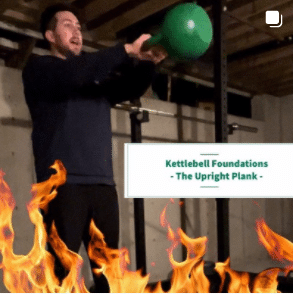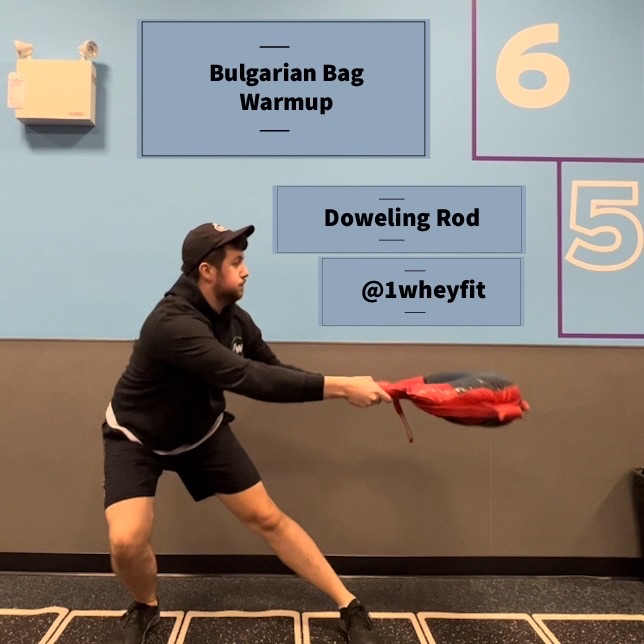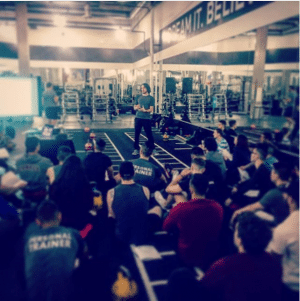September 6, 2017
The most effective way to ‘Tabata’: Have we been doing it wrong?
Anyone who has followed Fitness for the last 20 years knows what Tabata training is, but did you know it is a training foundation that originated from Izumi Tabata and its series of experiments first performed it in the late 1990s?
From these experiments, it was concluded that short-duration high-intensity exercise at approximately 170% of a person’s VO2 max exhausted both aerobic and anaerobic pathways during their specific 20 sec. on, 10 sec. off high-intensity “interval” protocols used during the experiment.
To this end, it’s clear that effective Tabata training requires very high intensities (i.e. high heartrates – HR or power outputs). The issue with today’s current fitness application of Tabata is that it doesn’t follow the scientific concepts it was founded upon. With that said, that’s ok, because in today’s 90% of the day sedentary lifestyle, “on like Donkey Kong” will kill the average fitness goer one 20 second interval at a time. To keep up that pace we’d need ibuprofen and paramedics in every group fitness class Tabata was taught… which isn’t realistic.
So now that we know Tabata as a training style is based on a specific application of science, and that it’s clearly not being applied correctly, let’s break this down into the following:
Endurance Training (ET): it is a continuous, non-interrupted, non-repeated cardiovascular session of set duration. While there can be fluctuations in intensity, heartrates are typically stable and below anaerobic threshold for the duration of the activity. For ex. 30 min of running on trails or 2hr hikes.
Interval Training (IT): is a combination of non-continuous cardiovascular events formed into work and rest segments. For ex. If I work 20s work followed by 10s rest is a 1: 0.5 work to rest interval. Therefore, strict Tabata training is a 1: 0.5 work to rest interval. Within this format heartrates fluctuate and are typically above anaerobic threshold during work and below during rest.
HIIT (High Intensity Interval) Training: a series of intervals with a defined high intensity (% of max heartrate – % of peak power (watts) – % of power at V02.
From the table below, it’s clear that HIIT training can be delivered in many forms using various modalities. Therefore, this article is designed to help demystify and identify best practice.
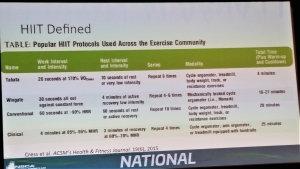
Anaerobic threshold: LT is the intensity of work or VO2 at which the blood lactate concentration gradually starts to increase during.
Continuous exercise: LT represents a point where the balance is altered, such that lactate production exceeds and removal. Practically is best defined as the point where someone performing a sustained activity can no longer manage the speed or intensity there currently working at. For example, if I were running on a treadmill at 8 miles per hour, but with my best efforts couldn’t keep up with the belt. But, if I slow the belt down to 7.5 miles per hour I’m able to continue running for a prolonged period of time.
Power/ work: Power is the work done in a unit of time. In other words, power is a measure of how quickly work can be done.
Vo2 Max (also maximal oxygen consumption, maximal oxygen uptake, peak oxygen uptake or maximal aerobic capacity): is the maximum rate of oxygen consumption as measured during incremental exercise, most typically on a motorized treadmill. To determine VO2 max, a client is put through a series of standardized increases in intensity to the point where they can no longer sustain running speed.
The Science of Tabata & Cardio
How do we improve Cardio?
1. Sustained effort endurance training: like riding a bike to Oregon in 60 min segments, which I just did. Or:
2. Short duration intervals. Intervals a combination of work and rest intervals. For ex. If I work 30s & Rest 4.5 min like the experiment pictured below. That is a 1:9 work to rest interval.
Which is of these methods is best? Many studies have been published, but this one is a classic, often cited one. 2 groups x 6 weeks:
Group 1: 30s work: 4 min rest x 4-6 reps (3x per wk.)
Group 2: 40-60 min sustained effort (5x per wk.)
Results:
1. Both groups improved their carb & O2 utilization as well as V02 similarly
2. Interval group worked 4x harder (based on avg watts) but performed 10 min of weekly total work vs 4.5 hr.
If you like reading on a treadmill, hate excessive sweating or have a ton of time, then cycle to Oregon. If time is an issue and or you like a little explosiveness in your training, then intervals it is. Essentially there is no “best” way, but there 2 different paths to success. Personal preferences and enjoyment (i.e. FITT-Enjoyment) really matter the most.
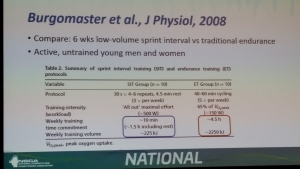
Other benefits specific to Tabata training are:
1. Higher sustained or avg heart-rates leads to
a. greater metabolic demand & calories burned
b. higher EPOC during the recovery intervals
c. increases V02 Max & anaerobic threshold, which helps improve cardio performance
d. Stimulates multi metabolic pathways at the same time
To maximize the benefits of Tabata you must do more work / unit of time, create a higher average of power or achieve a higher average HR per session. To achieve this, doing more of the following will help:
1. Increase distance per movement = higher jumps > than low jumps; wider > than narrow
2. Increase velocity per movement = running at 10mph > 8mph; cycling at 110rpm > 90rpm
3. Increase exercise density = 40 battle rope whips in 20s > 30 in same time; 15 air squats > 10
4. Increase ROM = 40 jump jacks arms clap overhead > shoulder height; burpees chest to ground > straight arm plank
5. Increase load per movement = 20 lb push press > 10lb; 40ft 2inch battle rope > 20ft
Therefore, effective results driven Tabata means how much of the above intensifiers can we safely and effectively achieve the following outcomes during training:
1. Anaerobic heartrates
2. Higher % of Max HR
3. Higher Percentage of sustainable ET outputs (i.e. % of V02max)
4. Greater calorie / min of exercise
5. Modest muscular trauma
How to Safely Bring the Scientific Tabata Intensity
Similar to the example I gave above referring to an aerobic threshold, when training the cardiorespiratory system, scientists often refer to intensity as the percentage of power or work being done relative to power or work at VO2 max. (I.e. 170% of VO2Max). While determining what that number actually is isn’t all that difficult, it’s more effort than anyone reading this article it prepared to do ‘ha-ha’. So, let me make this simple:
1. Hop on a treadmill
2. Warm-up gradually (increase speed fr 4mph to ___, .5 mph every min until you find a speed that is difficult to maintain
3. Recover for 2 min of walking then run again, this time for 1.2km. Whatever speed you can barely hold is what I will call the fitness MAS
4. This will be the speed & HR we will work off when programming Tabata for you. To do so, we will program at 120-140% of the MAS speed. This falls into the categories of HIT & RST (Repeated Sprint Training)
5. The right speed is one that you can run a 1-1 work to rest interval on (10-20s on 10-20s off). If your speed drops or you can’t keep up your fitness MAS is too high. It will likely be a 2-3km/hr. increase in speed. But remember everyone is different.
Put simply, it’s a speed, intensity or level that is significantly more difficult than the level where you were able to sustain your treadmill belt speed.
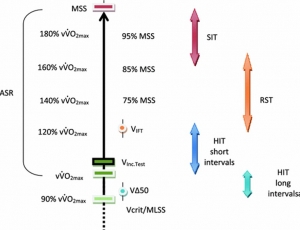
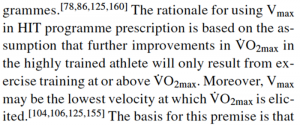
A bike might be the easier example…
Many cycle ergometer or spin bikes come with wattage indicators. If I were working at 400 Watts when I could no longer sustain my effort, then 170% of max is 400 x 1.7= 680 watts. Therefore, to perform a Tabata at 170% of VO2 max, I would repeat 20 seconds of 680 Watts followed by very light pedaling with very little resistance. If I repeat this effort 728 times I have replicated the conditions close to the experiments of lzumi Tabata.
Now, here’s where it gets interesting…
1. Who really works at that level while performing Tabata classes?
2. Are squats and lunges and push-ups and burpees truly the best way to execute the style of training?
3. And is 20 on and 10 seconds off the optimal interval to drive anaerobic threshold to its highest in a fitness environment, using treadmills speed ladders cycle ergometer etc.
4. Is it safe for the general population to work at this high of an intensity.
5. What are the health benefits and are they greater than sustained cardio?
RX:
15/15 interval running (15/15): The third group performed 47 repetitions of 15-s intervals at 90– 95% HR-max
Rules for Effective Fitness Tabata (HIT) for Fitness
1. Flip the current work to rest times (i.e. 1:1 or 2 Vs current 2:1 work to rest interval. Research has supported 15s on 15off for improved V02. I have successfully used 5-10s on 10-s20 off with very little HR drop. Having clients perform 7-8 sets of the same movement over and over with little break is kind of like participating in a bad drinking game. And, given that 1-2 sets are sufficient for most people, 8 sets create too much muscle tissue trauma, especially for new participants.
2. Allows greater PC (short sprint energy), keeping speed of execution higher for longer
3. The longer rest, depletes the energy system to a lesser degree, which keeps the brain / CNS from sending pain signals. Which means, longer rest is psychologically easier to deal with.
ADD PIC from NCSA
4. In a 1 on 1 training environment, vary & individualize interval length based on HR & recovery. Less fit people don’t recover as quickly as more fit individuals. Varying interval length from 5-20s will integrate different energy systems.
5. Instead of squats & lunges, use SAQ (ladder, line, hurdle, battle rope) drills particularly at the beginning of a session.
6. Lower (i.e. 1:1 or 2) work to rest intervals increase FAT Oxidation between sets.
7. Instead of 7-8 sets of each pattern, perform 3-4sets and then change exercises. Small changes can help keep client’s engaged challenged, will reduce the likelihood of extreme muscle soreness & stress on the associated joints.
Good Luck!
Blog by: Chad Benson, Lead Instructor @ BCPTI
References:
HELGERUD, J., K. HKYDAL, E. WANG, T. KARLSEN, P. BERG, M. BJERKAAS, T. SIMONSEN, C. HELGESEN, N. HJORTH,
R. BACH, and J. HOFF. Aerobic High-Intensity Intervals Improve V˙ O2max More Than Moderate Training. Med. Sci. Sports Exercise
Vol. 39, No. 4, pp. 665–671, 2007.
Tabata, Izumi et al (1997). Metabolic profile of high intensity intermittent exercises. Med Sci Sp & Exer., 29(3), 390-95.
Tags:
Related Posts
We’re here to help you!
Questions, comments or want to register? Fill out the form below and we will contact you shortly. Thanks!
"*" indicates required fields


